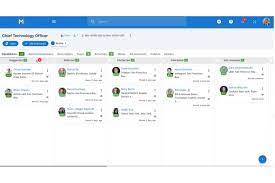Introduction
In the fast-paced and competitive world of business, the success of any organization heavily depends on its ability to hire and retain the right talent this give rise to recruiting database software. The traditional methods of recruitment, which involve sifting through countless resumes and conducting exhaustive interviews, have become inefficient and time-consuming. To address this, many businesses are turning to innovative solutions like recruiting database software to streamline their hiring processes.
The Importance of Recruitment in Modern Business
The Heartbeat of an Organization
Recruitment is the heartbeat of an organization. Without a constant influx of qualified and skilled individuals, a company’s growth and competitiveness can suffer. As technology and business landscapes evolve, so do the expectations for efficient hiring.
Challenges in Traditional Recruitment Methods
The Struggles of Traditional Hiring
Traditional hiring methods often involve manually reviewing resumes, coordinating interviews, and managing numerous candidates. These methods are not only time-consuming but can also lead to overlooking potentially valuable candidates.
Benefits of Recruiting Database Software
Efficiency and Precision
This provides a structured and systematic approach to hiring. It automates tasks, such as resume screening, candidate tracking, and interview scheduling. This not only saves time but also reduces the margin for human error.
Streamlined Collaboration
Modern recruitment often involves multiple stakeholders, from HR to department heads. Database software allows seamless collaboration and real-time access to candidate information, ensuring everyone is on the same page.
Features to Look for in Recruitment Software
Key Features
- Resume Parsing: Automatically extract relevant information from resumes.
- AI-Driven Matching: Match candidates to job profiles based on skills and qualifications.
- Interview Scheduling: Automate interview coordination and communication.
- Analytics and Reporting: Monitor and optimize the hiring process.
Types of Recruiting Database Software
Tailoring to Your Needs
There are various types, including cloud-based, on-premises, and industry-specific solutions. Choose the one that aligns with your organization’s unique requirements.
How to Choose the Right Recruiting Database Software
Considerations for Selection
When choosing recruitment software, factors like scalability, ease of integration, and user-friendliness are crucial. Also, seek feedback from your HR and recruitment teams.
Implementing and On boarding Recruitment Software
Seamless Transition
Once you’ve chosen the right software, the implementation phase is critical. Ensure proper training and a smooth transition to prevent disruptions in your hiring process.
Maximizing the Efficiency of Your Recruitment Process
Continuous Improvement
Regularly assess the software’s performance and gather feedback from your team. This will help fine-tune the process and achieve even greater efficiency.
Case Studies: Companies Benefiting from Recruitment Software
Real-World Success Stories
Explore case studies of companies that have benefited from recruiting database software, showcasing the positive impact on their hiring process.
Cost Considerations and ROI
Evaluating Costs
Calculate the costs involved in implementing recruiting software and measure them against the ROI you can expect from streamlined and efficient hiring processes.
The Future of Recruiting Database Software
Evolving Technology
As technology advances, recruitment software will continue to evolve. Stay updated with the latest trends and innovations to maintain a competitive edge.
Challenges and Pitfalls to Avoid
Common Mistakes
Identify and avoid common pitfalls in the implementation and use of recruiting software to ensure long-term success.
Integrating Recruitment Software with HR Systems
A Unified Approach
To maximize the benefits of recruitment software, consider integrating it with your HR management systems for a cohesive and efficient HR ecosystem.
Conclusion
By implementing recruiting database software, businesses can overcome the challenges and limitations of traditional hiring methods. The software offers a multitude of advantages, including faster and more efficient recruitment, improved candidate tracking, and better communication among hiring teams. It streamlines the entire process, from resume parsing to interview scheduling, leading to significant time and cost savings.
This technology also empowers organizations to make data-driven decisions by providing valuable insights into the hiring process. With analytics and reporting features, you can monitor every aspect of your recruitment efforts and optimize them for the best results. As a result, you not only hire faster but also hire smarter.
In an era where competition for top talent is fierce, recruiting database software is a competitive advantage. Companies that embrace this technology can attract and hire the best candidates before their competitors do, ensuring their continued growth and success.
So, if you’re looking to elevate your hiring process to the next level and stay ahead in the competitive job market, it’s time to consider adopting recruiting database software.
Finally, Incorporating recruiting database software into your organization’s hiring strategy can pave the way for a brighter future, where finding the right talent is easier, faster, and more cost-effective. It’s time to embrace this modern solution to stay competitive and lead the way in the ever-evolving world of recruitment.
FAQs about Recruiting Database Software
- What is the primary purpose of recruiting database software?
- It is designed to streamline the hiring process by automating tasks like resume screening, candidate tracking, and interview scheduling.
- How can I choose the right recruiting software for my organization?
- Select recruiting software based on factors like scalability, ease of integration, and user-friendliness. Seek feedback from your HR and recruitment teams to make an informed decision.
- What types of recruiting database software are available?
- There are various types, including cloud-based, on-premises, and industry-specific solutions. Choose the one that aligns with your organization’s unique needs.
- What is the return on investment (ROI) for using recruiting software?
- The ROI of recruiting software comes from the time and cost savings, as well as the improved quality of hires. Calculate the costs and measure them against the expected benefits to determine your ROI.
- How can I avoid common pitfalls when implementing recruiting database software?
- To avoid common mistakes, ensure proper training, gather feedback from your team, and regularly assess the software’s performance to fine-tune the process.
